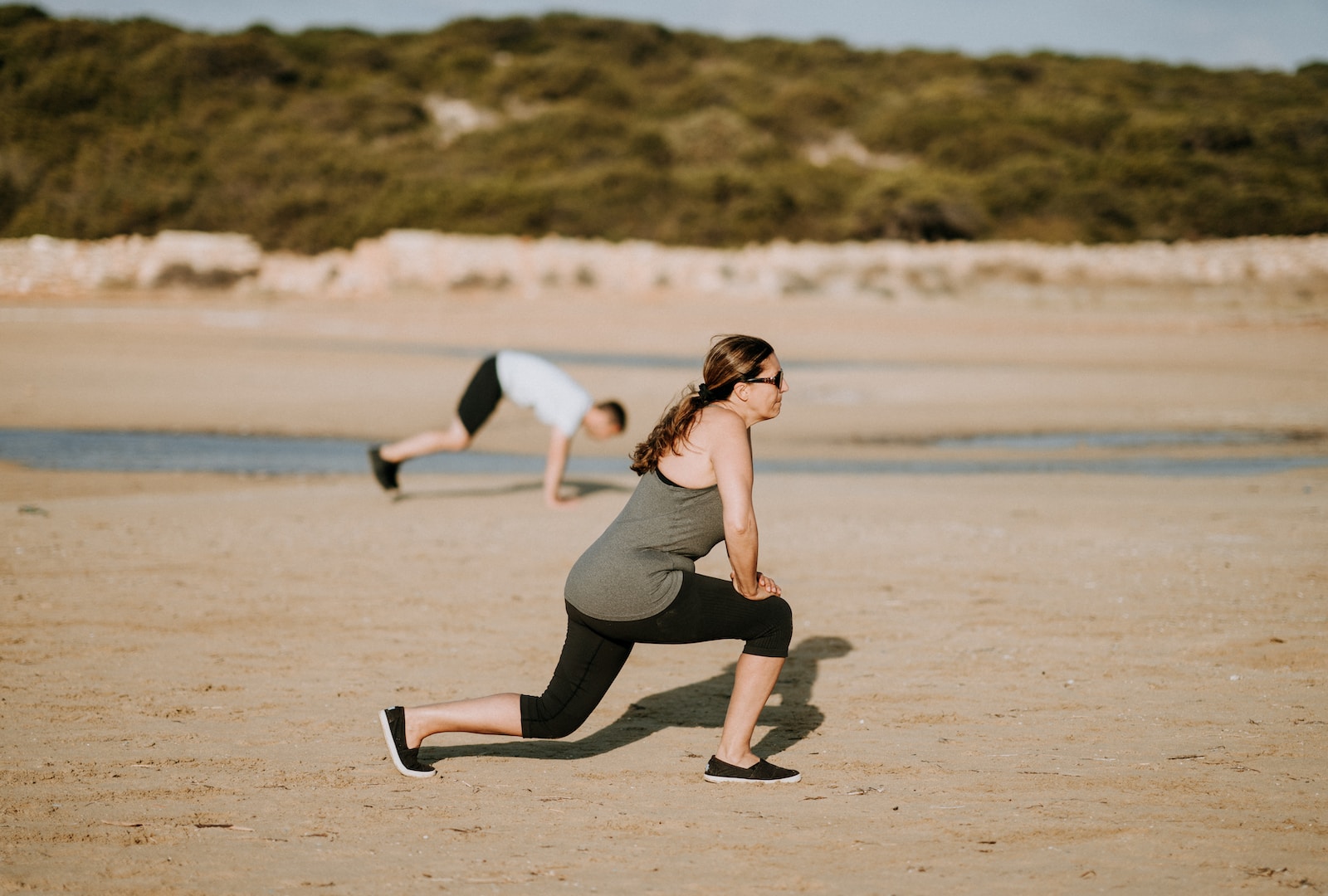If you’re looking for an effective lower-body exercise that can help improve your strength, balance, and flexibility, lunges are an excellent choice. But did you know that not all lunges are created equal?
In this section, we’ll explore the key differences between forward and reverse lunges, including the muscles they target and the benefits they offer. By the end of this article, you’ll have a better understanding of how each type of lunge can benefit your fitness routine.
Key Takeaways:
- Forward and reverse lunges are both effective lower-body exercises, but involve different muscle groups.
- Forward lunges primarily target the quadriceps and glutes, while reverse lunges work the hamstrings, glutes, and calves.
- Knowing the proper form for each type of lunge is essential for maximizing their benefits and minimizing the risk of injury.
Benefits of Forward Lunges
Forward lunges are an excellent exercise for developing lower body strength and improving overall fitness. Incorporating forward lunges into your workout routine can offer many benefits, both physical and functional. Here are a few of the key advantages of forward lunges:
- Targets Quadriceps and Glutes: Forward lunges primarily target the quadriceps and glutes, helping to tone and strengthen these muscle groups.
- Improves Balance and Coordination: Performing forward lunges requires balance and coordination, making it an effective exercise for improving these skills.
- Enhances Lower Body Strength: By targeting the legs and glutes, forward lunges can help improve lower body strength, making everyday activities, such as climbing stairs, easier.
- Increases Hip Flexor Mobility: The lunge movement in forward lunges can help increase hip flexor mobility, reducing the risk of injury and improving overall flexibility.
Overall, incorporating forward lunges into your workout routine can provide a well-rounded lower body workout, helping to improve strength, balance, and coordination. When performed with proper form and technique, this exercise can offer many benefits for individuals of all fitness levels.
Benefits of Reverse Lunges
While forward lunges primarily target the quadriceps and glutes, reverse lunges engage different muscles, such as the hamstrings and calves, creating a balanced lower-body workout. But that’s not all – incorporating reverse lunges into your routine can offer numerous benefits:
- Improved stability: Reverse lunges require your body to balance in a split stance, which can improve stability and coordination over time.
- Reduced risk of injury: Reverse lunges can help identify and correct any muscle imbalances that may lead to injury while performing daily activities.
- Enhanced performance: By engaging multiple muscle groups, reverse lunges can improve overall lower-body strength and athletic performance.
To execute reverse lunges with proper form, follow these simple steps:
- Begin standing with your feet hip-width apart and your hands on your hips or by your side.
- Step back with one leg, landing on the ball of your foot.
- Bend your front knee, keeping your back knee hovering above the ground.
- Push through your front foot to return to standing, then repeat on the opposite side.
When performing reverse lunges, be sure to keep your chest lifted, engage your core, and maintain balance throughout the movement. You can increase the difficulty of reverse lunges by holding dumbbells or adding a hop between lunges.
Proper Form for Forward Lunges
Forward lunges are a great way to target your quadriceps and glutes while improving your balance and lower-body strength. Here are the key steps to get the most out of your forward lunges:
| Step | Description |
|---|---|
| 1 | Start with your feet hip-width apart and your hands on your hips or at your sides. |
| 2 | Take a big step forward with your right foot, landing heel-first. |
| 3 | Bend your right knee and lower your body down until your right thigh is parallel to the ground. Make sure your knee is directly above your ankle. |
| 4 | Hold for a second or two, then push back up to the starting position. |
| 5 | Repeat on the other side, stepping forward with your left foot. |
When performing forward lunges, it’s important to keep your core engaged and your spine straight to avoid straining your lower back. Also, make sure your front knee does not extend past your toes. If you need to modify the exercise, you can start with smaller steps and work your way up to bigger lunges.
Here are some variations of forward lunges to add to your routine:
- Walking lunges, where you take several steps forward with each lunge.
- Jump lunges, where you jump and switch legs in between each lunge.
- Curtsy lunges, where you cross your back leg behind your front leg as you lunge forward.
By mastering the proper form for forward lunges and incorporating variations of the exercise into your workouts, you can improve your lower-body strength and balance while keeping your workouts interesting and challenging.
Proper Form for Reverse Lunges
Reverse lunges are a great way to target your hamstrings, glutes, and calves. To perform them correctly, follow these steps:
- Begin standing with your feet hip-width apart and your hands on your hips or by your sides.
- Step back with your right foot and lower your body until your left thigh is parallel to the ground.
- Your right knee should be hovering just above the floor.
- Push through your left heel to come back up to the starting position.
- Repeat on the other side by stepping back with your left foot.
Remember to keep your chest lifted throughout the exercise and engage your glutes to help maintain balance. Avoid leaning forward or allowing your knees to collapse inward.
To increase the intensity of your reverse lunges, you can try adding weights or incorporating a jump at the end of each lunge.
Muscles Worked in Forward Lunges and Reverse Lunges
Knowing which muscles are worked during exercises can help you tailor your workouts to achieve your fitness goals. Both forward and reverse lunges target the lower body, but the muscles worked differ slightly depending on the type of lunge.
Muscles Worked in Forward Lunges
The primary muscles worked during forward lunges are the quadriceps, glutes, and hamstrings. The quadriceps, located at the front of the thigh, are the main muscles responsible for extending and straightening the knee joint. The glutes, or buttocks muscles, are responsible for hip extension, which is necessary for movements like squatting and jumping. The hamstrings, located at the back of the thigh, are responsible for knee flexion and hip extension.
Other muscles worked during forward lunges include the core muscles, which are used to stabilize the spine and maintain proper posture throughout the movement.
Muscles Worked in Reverse Lunges
Reverse lunges engage many of the same muscles as forward lunges, but they place more emphasis on the hamstrings and calves. The hamstrings, which are responsible for knee flexion and hip extension, are used more during reverse lunges because the movement involves stepping back rather than forward. The calves, located on the back of the lower leg, are also activated more during reverse lunges than during forward lunges.
Other muscles worked during reverse lunges include the glutes, quadriceps, and core muscles.
It’s important to remember that balanced muscle development is essential for overall health and fitness. Incorporating both forward and reverse lunges into your workouts can help you achieve balanced muscle development in the lower body.
Variations of Forward and Reverse Lunges
Adding variety to your lunges can keep your workouts interesting and help target different muscle groups. Below are some examples of variations of both forward and reverse lunges to incorporate into your routine:
Variations of Forward Lunges
| Variation | Description |
|---|---|
| Walking Lunges | Perform a series of forward lunges while walking forward, alternating legs. |
| Curtsy Lunges | Step one foot diagonally behind the other, crossing the back leg behind to perform a lunge. |
| Side Lunges | Take a wide step to the side and bend the knee to perform a lunge, alternating legs. |
| Jump Lunges | Jump into the air and switch legs mid-air to land in a lunge position with the opposite leg forward. |
These variations can help target different muscles and add a cardiovascular component to your workout.
Variations of Reverse Lunges
| Variation | Description |
|---|---|
| Walking Lunges | Perform a series of reverse lunges while walking forward, alternating legs. |
| Reverse Lunge with Knee Drive | Perform a reverse lunge and then drive the back knee up towards the chest before stepping back. |
| Jumping Reverse Lunges | Similar to jump lunges, jump into the air and switch legs mid-air to land in a reverse lunge position with the opposite leg back. |
| Reverse Lunge with Leg Lift | Perform a reverse lunge and then raise the back leg straight behind you, engaging the glutes. |
These variations can help improve balance, coordination, and target different muscles in the lower body.
Conclusion
Regardless of whether you prefer forward lunges or reverse lunges, incorporating both types of lunges into your workout routine can provide a host of benefits for your overall lower-body strength and stability.
By performing lunges with proper form and incorporating variations of each exercise, you can challenge yourself further and continue to make progress towards your fitness goals.
Remember to listen to your body, start with lighter weights, and gradually increase the difficulty level as you become more comfortable and confident with each exercise.
So what are you waiting for? Start lunging your way to a stronger, more balanced lower body today!
FAQ
Q: What is the difference between forward and reverse lunges?
A: Forward lunges involve stepping forward with one leg and lowering the body until the front knee is bent at a 90-degree angle, while reverse lunges require stepping backward and lowering the body until the back knee is bent at a 90-degree angle.
Q: What are the benefits of forward lunges?
A: Forward lunges help improve balance, target the quadriceps and glutes, and enhance overall lower-body strength.
Q: What are the benefits of reverse lunges?
A: Reverse lunges engage different muscles compared to forward lunges, such as the hamstrings and calves. They can also improve stability and coordination.
Q: What is the proper form for forward lunges?
A: To perform forward lunges correctly, maintain proper alignment, engage the core, and avoid common mistakes. Variations of forward lunges can also add variety to your workouts.
Q: What is the proper form for reverse lunges?
A: To execute reverse lunges with proper form, keep the chest lifted, engage the glutes, and maintain balance. Different variations of reverse lunges can further challenge you.
Q: Which muscles are worked during forward lunges and reverse lunges?
A: Forward lunges primarily target the quadriceps, glutes, and hamstrings, while reverse lunges activate the hamstrings, glutes, and calves. Balanced muscle development is important.
Q: Are there any variations of forward and reverse lunges?
A: Yes, there are various variations of both forward and reverse lunges, such as walking lunges and jump lunges, which can increase the challenge and intensity of your training.
 Skip to main content
Skip to main content


